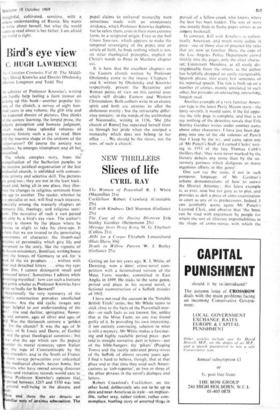Bird's eye view
C. HUGH LAWRENCE
The Christian Centuries Vol II: The Middle Ages David Knowles and Dimitri Obolensky Orton Longman and Todd 70s) An admirer of Professor Knowles's writing., can hardly help feeling a faint tremor on picking up this book—another popular his- tory of the church, a survey of eight hun- dred years in one volume, the glib title and the expected dossier of pictures. One thinks of the austere learning, the limpid prose, the elicate perception and humane judgment, which made those splendid volumes of ionastic history such a joy to read. How will the maestro shape in the uniform of the .ulgarisateur? Of course the anxiety was eedless ; he emerges triumphant and all buttw nscathed. The whole complex story, from the4! vangelisation of the barbarian peoples to he massive juridical organisation of the late ediae■ml church, is unfolded with consum- iate artistry and selective skill. The pictures re good too ; they are not in the least hack- eyed and, being all in one place, they illus- rate the changes in religious sentiment from ne age to another. The reader, whether he s a specialist or not, will find much treasure, specially among the masterly chapters on onastic life, theology, and religious send- lent. The narrative of such a vast period an only be a bird's eye view. The author's rtistry is shown by the places where he hooses to alight to take his close-ups. It here that we are treated to the penetrating csessments of character, the thumb-nail etches of personality which give life and ovement to the story, like the vignette of e Saxon missionary, Boniface, writing home om the forests of Germany to ask for 'a lok of the six prophets . . . written with ear and detached letters . . . since my eyes ow dim, I cannot distinguish small and nnected letters'. Sometimes I admire while maining mystified : how can such a humane d gentle scholar as Professor Knowles have Hen so badly for St Bernard?
Occasionally the very symmetry of the thor's construction provokes unsolicited estions. Are the old cyclic images any nger helpful to our understanding of the st? • --rise and decline, springtime, flower- and autumn, ages of silver and ages of Id. Was the thirteenth century a 'golden e' for the church? It was the age of St antis. of St Louis and Dante, of Gothic and the great theological summists ; but was also the age which saw the papacy dander its moral resources upon Italian rs. the rape of Constantinople by the tin crusaders, and in the South of France most savage persecution ever unleashed the mediaeval church; nearer home, few' torians who have rooted among diocesan* Lutes and visitation records would care to orse Professor Knowles's opinion thac.. period between 1215 and 1350 was 'one general well-being in the diocese and ish'.
ere and there the ear detects an amiliar note of anxious admonition. The papal claims to universal monarchy were sometimes made with an unnecessary stridency, which Professor Knowles deplores, but he refers them, even in their most extreme form, to a scriptural origin. Even in the bull Unam Sanctam, which appears to make the temporal sovereignty of the popes into an article of faith. he finds nothing which is not. on strict theological principles, implicit in Christ's words to Peter in Matthew chapter xvi.
It is here that the excellent chapters on the Eastern church written by Professor Obolensky come to the rescue. Chapters 7 and 8, written by Obolensky and Knowles respectively, present the Byzantine and Roman points of view on this central issue which still divides Eastern and Western Christendom. Both authors write in an eirenic spirit and both are anxious to allot the dishonour evenly ; but the intractable differ- ence remains : in the words of the archbishop of Nicomedia, writing in 1136, 'She [the church of Rome] has separated herself from us through her pride when she usurped a monarchy which does not belong to her office . . . We should be the slaves, not the sons, of such a church'.


































 Previous page
Previous page